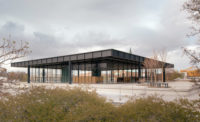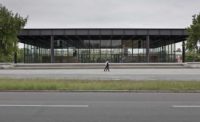David Chipperfield Architects Unveils Restoration of Venice’s Procuratie Vecchie
Instantly recognizable from the exterior, the 16th-century building on St. Mark’s Square will be partially accessible to the public for the first time in 500 years

The Procuratie Vecchie takes up the entire northern edge of St. Mark’s Square. Photo © Richard Davies
Architects & Firms
The most beautiful urban cores have always taken a long time to form, according to historian Sigfried Giedion. In Venice, it took 500 years of continuous transformations both of open spaces and the surrounding buildings for St. Mark’s Square to become a site of celebration of the human scale we recognize today. Le Corbusier cited its “visual acoustics” in attempting to grasp the essence of this public space. With such perspective, the restoration project of the Procuratie Vecchie (Old Procuracies) by David Chipperfield Architects Milan (DCA Milan) aims to enter the timeless symphony of evolution and renewal that is the city of Venice, contributing a new layer of contemporary depth to the composite legacy of St. Mark’s Square, its heart.

Behind the Procuratie Vecchie’s facade is Corte Maruzzi. Photo © Alessandra Chemollo
Named after the Procurators—officials considered second only to the Doge in prestige—of St. Mark, the Procuratie Vecchie is one of three buildings enclosing St. Mark’s Square, in front of the Basilica, the 500-foot-long Old Procuracies being the northern wing, the Procuratie Nuove (New Procuracies, 1583–1640) the southern wing, and the Procuratie Nuovissime (Newest Procuracies, 1807–14, also known as the Napoleonic Wing) on the west. Dating to the first half of the 16th century, the Old Procuracies portion was designed by, among others, architects Mauro Codussi, Bartolomeo Bon, and Jacopo Sansovino, who built upon an earlier damaged structure, making it an example of substitution and stratification from its very conception. The classical language of arches and loggias in which the Procuratie Vecchie were characteristically expressed would later go on to inspire its two later iterations.

The two new rooftop terraces offer views of St. Mark’s Basilica and the Campanile. Photo © Alberto Parise
This new intervention leaves the facade untouched and involved solely the interior of the building, just over 100,000 square feet, and yet it traces significant social and visual continuities with the public essence of its surrounding location. The deceptively “introverted” project, in fact, not only realizes the internal capacity of the Procuratie Vecchie, but in doing so also develops the extrovert potential of the building to relate to its setting, interacting with the social dimension of St. Mark’s Square with a reciprocity it had been denied by nearly half a millennium of public inaccessibility. Thus, both from within the Procuratie Vecchie and from its opened-up rooftop, the onlooker will now be able to gaze at St. Mark’s Square from a whole new range of angles and perspectives, breathing new life into the core of Venice.

Among the public spaces is an auditorium, on the fourth floor. Photo © Alberto Parise
The Procuratie Vecchie will open its doors to the city by making the fourth floor into a new space for exhibitions and events, and an auditorium connected to the Human Safety Net as its main purpose—a global foundation whose mission is to support people living in vulnerable circumstances. It was created by the Italian insurance company Assicurazioni Generali, the visionary and ambitious client and owner of the building that commissioned its physical and social transformation. The structure will also return to being a place of work in a city of tourists and museums, hosting offices on the second and third floors, the importance of which David Chipperfield underlines: “In many cases, the idea of an office building is rather boring, but we should not overlook how important it is that we are creating a workplace in the very heart of Venice, and that’s maybe an even more important symbol than opening up more touristic opportunities.”

1

2
An enfilade of arches (1) connects rooms on the fourth floor (2), where exposed brick walls contrast with timber ceilings. Photo © Alessandra Chemollo. Click to enlarge.
Faced with the introverted and extroverted identities of the Procuratie Vecchie—and with the complexity of the practical adaptations and functional modifications it underwent over the centuries—DCA Milan opted for a series of interventions rather than the overruling gesture of a genius architect, defined during two years of design and a three-year construction phase. The entire process was developed in close cooperation with the cultural and technical knowledge lent by local craftsmen, whose skill and ability in the construction phase proved so significant that their absence would have determined a very different outcome. As Chipperfield notes, “That’s what is really charming about working on restoration projects—the incredible engagement of craftsmanship, the close participation in the process. All construction sites should be like that.”

Between the two terraces, a new roof encloses a grand staircase. Photo © Alberto Parise
The architects adopted a clever, flexible approach, “a delicate balance between conservation and integration,” according to DCA Milan associate director Cristiano Billia, one that involves revelation and renovation. Revelation uncovered, for instance, traces of frescoes (on the third floor), ancient flooring in Venetian terrazzo on the second floor, and juxtapositions of brick wall patterns of different time periods on the fourth floor. Integration was needed for the replacement of elements where the original ones were damaged and could not be preserved. Renovation of the fourth floor highlighted the historical traces and material stratification of the building, opening it to a brandnew social life linked by a stunning long promenade of arches connecting the different rooms and divided by the serial sequence of the structural walls. Besides this new horizontal connection, the vertical circulation was reorganized into blocks of wide, open stairs inside the courtyards, without affecting the main spaces of the building, in a dialogue between contemporary interventions and existing historical layers.

Model showing new vertical circulation. Image courtesy David Chipperfield Architects
The restoration work recovered original Venetian materials—such as pastellone (a smooth lime flooring), marmorino (a classic Venetian plaster for internal walling), scialbatura (whitewashing), cocciopesto (very small pieces of tiles mixed with mortar for external walling), cotto (suitable for coating), and terrazzo—as well as traditional techniques requiring the specialized craftsmanship of local companies and artisans, with the aim of grounding the project in its cultural heritage— a complex process of integration and alteration of the layers that formed it over the course of several hundred years. The technical solutions, as well as those for building services, show a respectful minimalist approach to the existing structure. Regarding energy sustainability, the building is aiming for international LEED Silver Core & Shell certification.

The new building entrance. Photo © Alberto Parise
Finally, it is worth remembering that the Procuracies are also home to Carlo Scarpa’s celebrated Olivetti store (1958) on the ground floor, where the topic of historical presence and modernism finds its highest expression. A further link between the Venetian Procuracies and modernism may be found in DCA’s restoration projects in Berlin, such as Mies van der Rohe’s Neue Nationalgalerie (1968, renovated by DCA 2021) and, in particular, Friedrich August Stüler’s Neues Museum (1859, restored by DCA 2009). Perhaps surprisingly, Venice was the museum’s primary reference—so much so that when Chipperfield’s office tackled the German masterpiece, they thought back to Venice as a laboratory for learning a living tradition of repairing, one in which, according to Chipperfield, “there is no radical statement—it’s just about trying to, softly, maintain the fabric that is left and give it coherence. In a sense, we’ve come back to where it really began.” And where it continued with the restoration project of the Procuratie Vecchie as a respectful and profound dialogue with its slow, historical, sociospatial, and cultural sedimentation.

3

4
Historical Elevation of Piazza San Marco (3). Piazza San Marco site plan (4). Images courtesy David Chipperfield Architects



